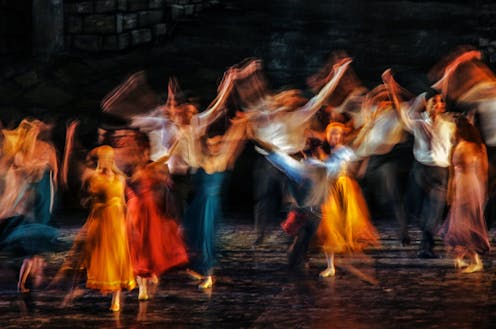
The past term of government has been tough for arts and culture in Australia. Culture was among the worst affected by the pandemic of any aspect of society: the first to lock down; the last to have health restrictions lifted.
Culture is also recovering slowly. Shows at key festivals are still being cancelled due to COVID-19. The damage to the sector has been so deep that informed observes believe it will take years to fully recover.
Despite this, the arts and culture have been disappointingly absent from the 2022 election campaign.
Read more: How do the major parties compare on arts and cultural policy? We asked 5 experts
Those looking for a genuine vision for Australian arts and culture won’t find it with the major parties.
The Coalition has not put out an arts or cultural policy, instead running on its record of pandemic stimulus and a claim of record funding) to the arts portfolio in the most recent budget.
That is cold comfort for a sector still struggling to recover from its biggest setback in a century. March’s federal budget slated funding cuts of roughly 19% for the federal arts portfolio that Paul Fletcher heads.
The Australian Labor Party released its policy on Monday evening at the Espy Hotel in Melbourne. Labor’s arts platform at this election is surprisingly modest.
Labor’s arts spokesperson Tony Burke gave a wide-ranging address which touched on Labor’s history of cultural policy at the federal level. There were also some bite-sized policy commitments, such as $84 million for the ABC and $80 million for a First Nations art gallery in Alice Springs.
According to Burke, Labor will “relaunch” a cultural policy if elected, promising to consult widely. But there are few specific or concrete promises, and many decisions are deferred.
Notably, there was no promise of new money for the Australia Council, the nation’s primary federal cultural agency. Labor has also refused to make a specific promise on local content quotas for streaming platforms like Netflix. As of publication, Labor’s arts policy wasn’t even published on the party’s campaign website.
Big visions
There are some genuinely big visions being advanced for the arts and culture in this election. They are coming from independents such as Allegra Spender in Wentworth and Jo Dyer in Boothby, and especially from the Greens.
In particular, the Greens’ Sarah Hanson-Young has put forward the kind of big-picture blueprint for a renewed cultural policy that 30 years ago was advanced by Paul Keating.
Read more: Paul Keating’s Creative Nation: a policy document that changed us
There are transformative funding promises, including a $1 billion content fund for Australian screen production and another $1 billion for the performing arts. The Greens want to double the Australia Council’s funding, ramp up funding for game production, and inject $30 million into the Indigenous media sector.
You could argue such promises are cheap, because there is no political scenario in which the Greens will sit on the government benches or control the Treasury. But their policy is also strong on regulation, where a Greens cross-bench will likely wield significant legislative power in the next Senate.
The Greens are pushing for streaming platforms to invest 20% of their earnings from Australian subscribers into Australian content (some of the teal independents are also backing this). If implemented, it will lock in meaningful levels of local content on Australian screens.
The most original proposal put forward by the Greens is their policy for a trial of a basic income for artists, paying up to 10,000 artists $772.60 a week for a year. The policy is modeled on a trial of basic incomes for artists in Ireland, where it is specifically targeted at redressing the crippling precarity of cultural labour markets.
Hanson-Young spruiks her policy as supporting artists “to develop their craft, build their portfolios and support them to keep creating.” By directly seeking to create income for artists, it is a potentially far-reaching policy intervention.
Read more: Australia should have a universal basic income for artists. Here's what that could look like
Moving the mainstream
The artists’ wage proposal is clearly a long way off being legislated in Australia. But putting forward new ideas is a critical role for minor parties. As John Maynard Keynes recognised in the 20th century, policy ideas that seem far-fetched today can quickly move to the mainstream when the winds of change blow in the right direction.
With the Coalition increasingly preoccupied with the prosecution of culture wars, and Labor huddled in a defensive crouch, it is now up to the minor parties and independents to advance a larger vision for Australian culture in the next term of government.
If the cards fall her way in the Senate, Hanson-Young may be in a position to drag Labor towards implementing some bold ideas.
Ben Eltham has previously received funding from the Australia Council for the Arts. He is affiliated with the Centre for Future Work at The Australia Institute, where he has previously co-written a report about federal cultural policy. He is a member of the Media, Entertainment and Arts Alliance (MEAA), a union that represents workers in the cultural sector.
This article was originally published on The Conversation. Read the original article.







